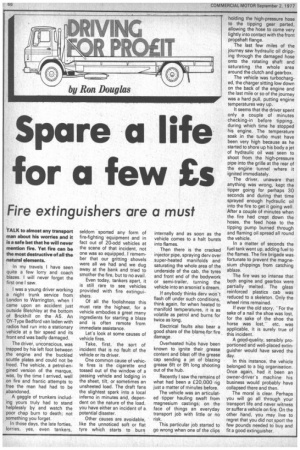Spare a life for a few Es
Page 68

If you've noticed an error in this article please click here to report it so we can fix it.
Fire extinguishers are a must
TALK to almost any transport man about his worries and it is a safe bet that he will never mention fire. Yet fire can be the most destructive of all the natural elements.
In my travels I have seen quite a few lorry and coach blazes. I will never forget the first one I saw.
I was a young driver working a night trunk service from London to Warrington, when I came upon an accident just outside Bletchley at the bottom of Brickhill on the A5. An OY-Type Bedford van laden with radios had run into a stationary vehicle at a fair speed and its front end was badly damaged.
The driver, unconscious, was trapped by his left foot between the engine and the buckled scuttle plates and could not be freed. The vehicle, a petrol-engined version of the marque, was, by the time I arrived, well on fire and frantic attempts to free the man had had to be abandoned.
A gaggle of trunkers including yours truly had to stand helplessly by and watch the poor chap burn to death; not .something you forget.
In those days, the late forties, lorries, yes, even tankers, seldom sported any form of fire-fighting equipment and in fact out of 20-odd vehicles at the scene of that incident, not one was so equipped. I remember that our gritting shovels were all we had and we dug away at the bank and tried to smother the fire, but to no avail.
Even today, tankers apart, it is still rare to see vehicles provided with fire extinguishers.
Of all the foolishness this must rate the highest, for a vehicle embodies a great many ingredients for starting a blaze and is often remote from immediate assistance.
Let's look at some causes of vehicle fires.
Take, first, the sort of incident that is no fault of the vehicle or its driver.
One common cause of vehicle fires is the cigarette end tossed out of the window of a passing vehicle and lodging in the sheet, tilt, or sometimes an unsheeted load. The draft fans the slightest spark into a local inferno in minutes and, depen dent on the nature of the load, you have either an incident of a. potential disaster.
Other causes are avoidable, like the unnoticed soft or flat tyre which starts to burn internally and as soon as the vehicle comes to a halt bursts into flames.
Then there is the cracked injector pipe, spraying dery over super-heated manifolds an-d saturating the whole area of the underside of the cab, the tyres and front end of the bodywork or semi-trailer, turning the vehicle into an arsonist's dream.
If anybody thinks dery won't flash off under such conditions, think again, for when heated to manifold temperatures, it is as volatile as petrol and burns for twice as long.
Electrical faults also bear a good share of the blame for fire damage.
Overheated hubs have been known to ignite their grease content and blast off the grease cap sending a jet of blazing grease 6ft or 8ft long shooting out of the hub.
Recently I saw the remains of what had been a £20,000 rig just a matter of minutes before.
The vehicle was an articulated • tipper hauling swaft from magnesium castings; on the ,face of things an everyday transport job with little or no risk.
This particular job started to go wrong when one of the clips holding the high-pressure hose to the tipping gear parted, allowing the hose to come very lightly into contact with the front propshaft flange.
The last few miles of the journey saw hydraulic oil dripping through the damaged hose onto the rotating shaft and saturating the whole area around the clutch and gearbox.
The vehicle was turbocharged, the charger sitting low down on the back of the engine and the last mile or so of the journey was a hard pull, putting engine temperatures way up.
It seems that the driver spent only a couple of minutes checking-in before tipping, during which time he stopped his engine. The temperature soak in the turbo must have been very high because as he started to shore up his body a jet of hydraulic oil was seen to shoot from the high-pressure pipe into the grille at the rear of the engine tunnel where it ignited immediately.
The driver, unaware that anything was wrong, kept the tipper going for perhaps 30 seconds and during that time sprayed enough hydraulic oil into the fire to get it going well. After a couple of minutes when the fire had crept down the hoses, the feed hose to the tipping pump burned through and flaming oil spread all round the vehicle.
In a matter of seconds the fuel tank went up, adding fuel to the flames. The fire brigade was fortunate to prevent the magnesium chippings from catching ablaze.
The fire was so intense that both engine and gearbox were partially melted. The glass reinforced plastics cab was reduced to a skeleton. Only the wheel rims remained.
If ever the old story, "For the sake of a nail the shoe was lost, for the sake of the shoe the horse was lost," etc, was applicable, it is surely true of this incident.
A good-quality, sensibly proportioned and well-placed extinguisher would have saved the day.
In this instance, the vehicle belonged to a big organisation. Once again, had it been an owner-driver's machine his business would probably have collapsed there and then.
The moral is clear. Perhaps you will go all through your transport life and never witness or suffer a vehicle on fire. On the other hand, you may live to regret that you did not sport the few pounds needed to buy and fit a good extinguisher.




































































































































